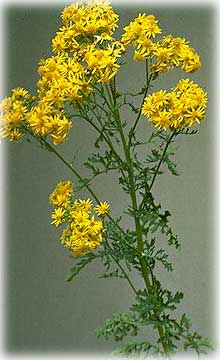 July 22, 2005
All plant parts of the Tansy Ragwort are toxic, with the highest amount of alkaloids in the flowers, followed by the leaves, roots, and stems.
Introduced from Europe and Western Asia, this non-native plant has taken over thousands of acres of valuable crop and rangeland in the lower 48, and has taken root along roadsides and on private properties in Ketchikan, particularly north of town. Tansy Ragwort reproduces by seed and also vegetatively through root and crown sprouts. Each plant can produce between 5,000 and 200,000 seeds per season. Tansy Ragwort is an aggressive invasive weed that will establish itself in disturbed sites such as roadsides and vacant lots. The Forest Service is interested in keeping the Tansy Ragwort from spreading into National Forest System lands around Ketchikan. For now, it seems to be established primarily on state and private property. Only private landowners have the authority to eliminate it from their property. "Our goal is to participate with the community to control the spread of this plant before the population becomes unmanageable," said Tongass National Forest Invasive Species Coordinator Pam Fletcher. According to Fletcher, to eliminate Tansy Ragwort, the entire root system must be pulled up. It may help to loosen the soil with a shovel first. Gloves and protective clothing should be worn before handling the weed, since the plant toxins may be absorbed through the skin. The best time to pull the weed is just as its beginning to flower, but definitely before it begins producing a new crop of seeds. The flowering head should be cut off and placed in a plastic bag before pulling the plant, to avoid any potential seed dispersal. Plants should be disposed of by either burning, or by placing all plant parts in a plastic bag before disposing to prevent further spread of this invasive weed. According to the Forest Service, the Ketchikan landfill has offered to incinerate plants contained in a plastic bag. Call ahead at 225-2370 to check on the incinerator schedule. Usually the incinerator runs on Wednesdays. Here are a few reasons why the Forest Service views invasive plants, such as the Tansy Ragwort, as more than just nuisances, but real threats:
To help educate Ketchikan residents about local invasive plants, Sarah Moore, Integrated Pest Management Technician with the Cooperative Extension Service at the University of Alaska, Fairbanks, is presenting a talk at 6:30 p.m., Aug. 10 at the Southeast Alaska Discovery Center, 50 Main Street, in Ketchikan.
On the Web:
Source:
Publish A Letter on SitNews Read Letters/Opinions Submit A Letter to the Editor
|
||
